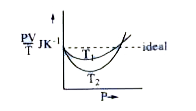(A): Two gases with the same average translational kinetic energy have same temperature even if one has greater rotational kinetic energy than the other.
(R): Only average translational kinetic energy of a gas contributes to its temperature. Solution in Telugu
Both (A) and ( R) are true and (R ) is the correct explanation of (A)
Both (A) and (R ) are true and (R ) is not the correct explanation of (A)
(A) is true but (R ) is false
Both (A) and (R ) are false
The correct Answer is:A
Step by step video, text & image solution for (A): Two gases with the same average translational kinetic energy have same temperature even if one has greater rotational kinetic energy than the other. (R): Only average translational kinetic energy of a gas contributes to its temperature. by Physics experts to help you in doubts & scoring excellent marks in Class 11 exams.
Updated on:21/07/2023Topper's Solved these Questions
- KINETIC THEORY OF GASESBOOK - AAKASH SERIESCHAPTER - KINETIC THEORY OF GASESEXERCISE - EXERCISE-2(Kinetic Theory of an ideal gas)
25 Videos
- KINETIC THEORY OF GASESBOOK - AAKASH SERIESCHAPTER - KINETIC THEORY OF GASESEXERCISE - EXERCISE-3(Kinetic Theory of an ideal gas)
4 Videos
- KINETIC THEORY OF GASESBOOK - AAKASH SERIESCHAPTER - KINETIC THEORY OF GASESEXERCISE - EXERCISE-IA(Degree of Freedom)
35 Videos
- KINEMATICSBOOK - AAKASH SERIESCHAPTER - KINEMATICSEXERCISE - ADDITIONAL PRACTICE EXERCISE (PRACTICE SHEET (ADVANCED)) (Integer Type Questions)
12 Videos
- LAWS OF MOTIONBOOK - AAKASH SERIESCHAPTER - LAWS OF MOTIONEXERCISE - PRACTICE EXERCISE
108 Videos
Similar Questions
cylinder of capacity 20 litres is filled with H2 gas. The total average kinetic energy of translatory motion of its molecules is 1.5×105 J. The pressure of hydrogen in the cylinder is
View SolutionGiven is the graph between PV/T and P for 1 gm of oxygen gas at two different temperature T1 and T2 (Given:Density of oxygen=1.429kg/m3).The value of PV/T at the point A and the relation between T1 and T2 and respectively

View SolutionA cylinder rolls without slipping down an inclined plane, the number of degrees of freedom it has, is
View SolutionThree particles start from origin at the same time: one with velocity v1 along positive x - axis, the second along the positive y-axis with a velocity v2 and the third along the line y=x with such a speed that all the three always stay in a straight line, then the velocity of the third particle is √kV1V2(V1+V2).
View SolutionA force of 50 N acts on a body of mass 10 kg at rest. Its velocity after 5 seconds if the same force acts, is
View SolutionAssertion: A solid sphere and a hollow sphere are rolling on ground with same total kinetic energies. if translational kinetic energy of solid sphere is K, then translational kinetic energy of follow sphere should be greater than K.
Reason: In case of hollow sphere rotational kinetic energy is less than its translational kinetic energy.
View SolutionAt a given temperature, rotational kinetic energy of diatomic gas is K_(0) . Find its translational and total kinetic energy.
View SolutionThe average rotational kinetic energy of hydrogen molecule at a temperature T is E . The average translational kinetic energy of helium at same temperature will be:
View SolutionA : Two gases with the same average translational kinetic: energy have same temperature even if one has greater rotational energy as compared to other. R : Only average translational kinetic energy of a gas contributes to its temperature.
View SolutionThe average translational kinetic energy of gas molecules depends on
View SolutionThe average translational kinetic energy of gas molecules depends on
View SolutionThe average translational kinetic energy of gas molecules depends on
View SolutionTwo different gases at the same temperature have the same average kinetic energy.
View Solutionताप T पर द्विपरमाण्विक अणु की औसत स्थानान्तरीय गतिज ऊर्जा व घूर्णी गतिज ऊर्जा का अनुपात होगा
View Solution(A): According to the law of equipartition of energy, internal energy of an ideal gas at a given temperature, is equally distributed in translational and rotational kinetic energies. (R) : Rotational kinetic energy of a mono. atomic gas is equal to its translational kinetic energy
View Solution
